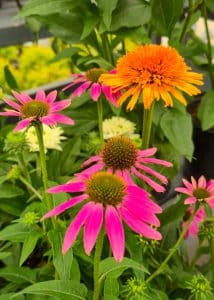 Native Roots, Modern Appeal
Native Roots, Modern Appeal
If you’re searching for a perennial that’s beautiful, tough, low-maintenance, and beloved by pollinators, look no further than the coneflower. Known botanically as Echinacea, this North American native has come a long way from its prairie origins. With an ever-expanding palette of colors, forms, and sizes, coneflowers have earned their place as a must-have in modern gardens.
Originally found across the central and eastern U.S., coneflowers were prized by Indigenous peoples for their medicinal properties and by early settlers for their rugged resilience. Today, gardeners value them just as much- but for their ornamental traits and eco-friendly benefits.
Coneflowers thrive in full sun and well-drained soil, and once established, they’re impressively drought tolerant. They return year after year, steadily forming clumps of upright stems topped with daisy-like flowers that attract bees, butterflies, and other beneficial insects. Even as the blooms fade, their spiky seedheads continue to provide visual interest and act as a winter buffet for seed-eating birds, especially goldfinches.
Varieties We Love
While the classic Echinacea purpurea produces large purple-pink blooms with orange cone centers, today’s cultivars come in nearly every color of the rainbow- from sunny yellows and fiery oranges to vibrant reds and soft whites with single, double, and even bicolor blooms.
Some standout series to look for include:
- Sunseekers™ Series
- Living up to their name, these coneflowers burst with rich, sun-drenched colors in unique blends. The Sunseekers line boasts strong stems and a bushy habit, perfect for cutting gardens and vibrant borders. Look for their fiery oranges, watermelon pinks, and glowing sunset tones on semi-double blooms.
- PowWow® Series
- Compact, tidy, and bloom-rich, the PowWow series fits small spaces or containers. ‘PowWow Wild Berry’ shines with intense magenta-pink petals and a long flowering period. These plants don’t need deadheading, making them one of the easiest options around.
- Sombrero® Series
- Bold and bright, Sombrero coneflowers are known for their saturated hues and excellent branching. They bloom earlier and last through summer’s end. Look for vivid reds, oranges, and yellows to light up any landscape.
A Pollinator and Wildlife Magnet
Few perennials match coneflowers in ecosystem benefits. Their nectar-rich blooms lure bees, butterflies, and even hummingbirds. Later, the dried seedheads offer vital food for birds, especially finches.
By leaving seedheads through fall and winter, you provide habitat and food for wildlife while enjoying seasonal interest through dark silhouettes against frost or snow.
Tips for Growing Coneflowers
- Sunlight: Full sun (at least 6 hours/day) is best. Too much shade can make them leggy, pale, and less floriferous.
- Soil: Well-draining soil is crucial. They dislike soggy roots and may struggle in heavy clay without added organic matter.
- Water: Keep soil moderately moist the first year. Once established, they handle dry spells well.
- Deadheading: Not necessary, but removing spent blooms can encourage repeat flowering. Alternatively, leave them to feed the birds!
- Dividing: Every 3–4 years, divide clumps in early spring or fall to prevent overcrowding.
Coneflowers thrive in pollinator gardens, cottage-style borders, wildflower meadows, cut flower beds, containers, and small gardens. They pair beautifully with ornamental grasses, black-eyed Susans, rudbeckias, yarrow, and salvia- plants with similar growing needs and bloom times!
Coneflowers Have It All
Extended bloom time, wildlife support, color diversity, low upkeep, and native adaptability… Whether you’re creating a prairie-style landscape, refreshing a sunny border, or just want a few dependable perennials, coneflowers are a smart choice.

